Set & Costume
Read our interview with Olivier award-winning set and costume designer, Lez Brotherston. Lez is also an Associate Artist of the company and has worked on many New Adventures productions.
Inspiration & Design
Having designed the original Swan Lake production in 1995 can you explain how it feels to be revisiting the show 23 years later, and what are the biggest opportunities and challenges that you face as a designer when working on a restaging, such as this?
For the last 10 years, the show has been leased to another company so I am really pleased to now have the opportunity to ‘get hold’ of the company’s flagship show once again and to remake a lot of the things.
There were elements of the original show, like the ‘Soho scene’, that I thought were dated – not only in terms of the physical ‘things’, but actually in terms of ideas too. ‘Soho’ was done originally on very, very little money and those costumes, and those decisions, still stood 20 years later. So, it was very nice to meet with Matthew and look at it again. I don’t think any of the characters are known by 19-year old people who are in the company now. In-fact, they were barely known by the people who did the show 20 years ago!
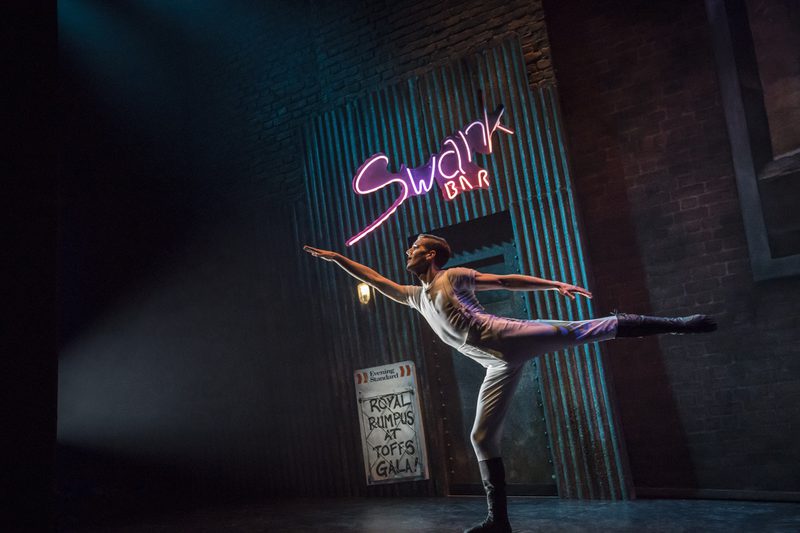
They don’t know who Beryl Reid (British actress of stage and screen) is, for example, they don’t know who these people (that were our sources of reference at the time) are, so it was great to be able to say “let’s find something else” and make ‘Soho’ a little bit more stylish and a bit more contemporary. When we designed it last time, the choreography for that section hadn’t yet been made, and so now, knowing what the choreography is, I was suggesting to Matthew that it would be better if the dancers were all dressed pretty-much the same, rather than lots of different characters which makes it harder to read what the steps are.
We made some decisions about the ‘Princesses’ too, as the Princesses have been the (designs) that have changed most over the years, and certainly for the first 10-12 years of the show, we used to re-look at the Princesses quite a lot. But actually, the last time I did the design for the Princesses I thought they were the best Princesses we’d ever done, so I said to Matthew, “let’s stick with these, because they’re good and we know they ‘work’ – they don’t need re-designing, they don’t ned re-making, let’s keep them”, and in my opinion I don’t think they’ve dated.
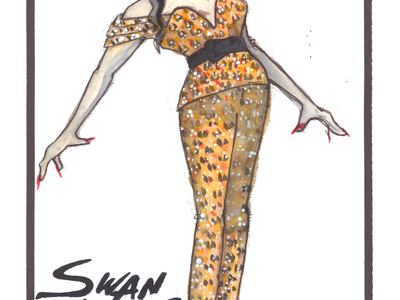
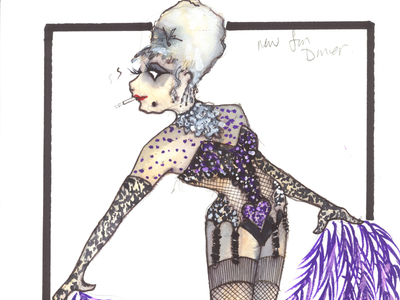
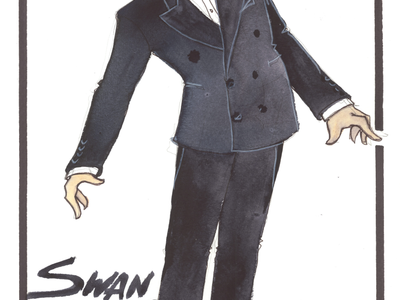
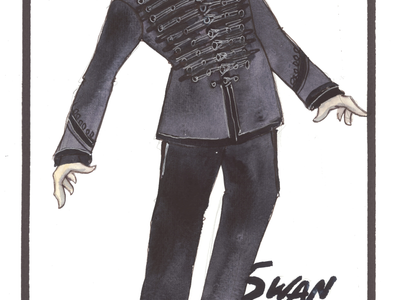
It has really just been an opportunity to look at a show that we designed 20-odd years ago and was great to decide how we can do some things better. Also, we’ve been able to make some things happen that I’d wanted to do 23 years ago, but we couldn’t afford to do at that time. For example, the video of the swans that we have at the beginning of the show now – this used to be just a static image on painted gauze and technology wouldn’t allow us to do what we can do now, but I used to say “wouldn’t it be brilliant if that image could move!”
The new staging of the show is being presented as having a fresh look for the 21st century. Can you give us any insights into what changes the audience might expect to see?
There are many changes. However, what we didn’t want to do was to completely ‘blow what we had out of the water’ and start again. This has been about looking at what elements we perhaps did quickly or without fully understanding what they would be used for, at that time, and finding a way to refine and improve these.
It’s all been completely re-built and completely re-made, and some of it’s been re-designed, but I hope that the families who have liked the show for a long time won’t really notice. I hope they will just think it’s fresher and newly built, but actually there’s a lot of little things that have completely changed. For example, the shape of the back wall and the way the pillars have been designed so they now go back ‘in perspective’.
There’s a refining of it and a sophistication in it now that wasn’t there before, and also, we’ve learnt a lot during these past 23 years and we’ve moved on. We certainly weren’t beginning our careers then, but we weren’t that far into them. Now with 20-odd years of experience we can look at something and go, “I know how to make that better”.
I don’t think anyone wants to come along to see (our version) of Swan Lake and see a completely different show from the one they saw two decades ago. The only thing Matthew and I did talk about changing substantially was the character of the ‘Unsuitable Girlfriend’, with the advent of Meghan Markle and Kate Middleton joining the Royal Family. However, I felt very strongly that Meghan and Kate are eminently suitable – they are the perfect Princesses and exactly what we need.
It had certainly never been my intention, but some people had compared that character previously to ‘Fergie’ (the Duchess of York).
What we needed to have with this character, is someone who is ‘wrong’. They look wrong and they feel wrong, and that pink puffball dress, which the character wore originally and which is very ‘80’s’, was something I very much felt we should just stick with. It tells the story well, and so I felt that there was no point in changing it. We’d be changing it just because there are two new Princesses ‘on the block’ (than there were in 1995) and actually, they are not unsuitable!
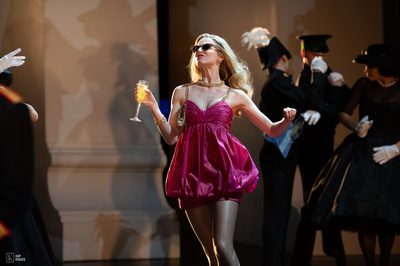
The only thing we did change is that when she comes on again in the last Act, I don’t think the audience were ever completely sure, at least not straight away, that this was the same character returning because her hair was different and her dress was very different. So, this time, when the character of the ‘Unsuitable Girlfriend’ appears back on stage, she is in the same puffball dress, but in black for ‘evening’.
The costumes and styling of the male swans almost instantly seemed to become the most iconic image of Matthew’s Swan Lake. Can you explain your original inspiration for this look and if there have been any changes?
The one idea that Matthew did come to me with, very strongly, right at the beginning when we first made Swan Lake, was that he wanted to have the Swans danced by men; and so that’s where we started from.
We spoke about this idea that if they are to be men dancing the role of the Swans then male swans are actually quite aggressive and vicious; and they’re strong. So actually, covering up the body seemed pointless. We wanted to see muscles, we wanted to see body work and we wanted to see as much as we could. So, then you wonder about giving them some kind of shorts. At that point, we were early on in the design process and Matthew had a picture of an Indian dancer who was wearing fringing; and he quite liked the idea that this fringing moved.
I then took that idea and worked with a maker called Phil Reynolds and we did some prototypes of building up silk chiffon in petal / feather shapes so we could move them. The sizes of the petals are graded, so you alter the shape of the leg a bit. They are bigger at the top and you make them narrower at the knee. They’re quite a complicated make and so you are trying to change the shape from a human leg to some kind of animal / animalistic leg.
We made prototypes in many different kinds of fabrics, but the chiffon is the most ‘friendly’. When you first make them they’re very fluffy and then when you wash them a few times the silk chiffon starts to twist and ‘dread-up’ a bit and they go like dreadlocks, which is nice and I like them best when they’re about 3-4 weeks into the run because they’ve ‘collapsed’ a bit but they still move well. It was really a combination of showing the dancers move and showing muscles move
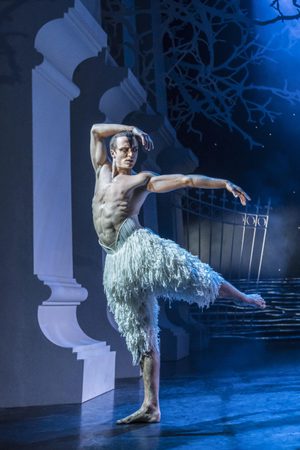
Apart from once, the Swan costumes, have always been made by Phil Reynolds. He has literally made hundreds and hundreds of those Swan legs over the years and is like a production line when he gets going! He contributed to the way we made them. We spoke about them, we prototyped them, and they’re as much ‘his’ as they are ‘mine’. The V&A have got a pair and also a couple other museums; and endless Swans have stolen them!
One of the things we spoke about this time around was “do we need to put the white body paint on the Swans?” and I felt quite strongly, that paint was still very important. It’s about trying to make them tribal and making them ‘not-human’. And of course, what happens when they’ve got white body paint on, is that when they start to sweat it goes into a ‘mess’ and the Swans start to look really ferocious and it becomes like war-paint. So, I said, “please – let’s not cut the body paint” – it really makes them look, by the end of the show, like they’ve ‘been through the wars’. I love it when it’s smeared and messy as I think it makes them more powerful. We’re not trying to make them pretty and white, we’re trying to make them seem like a bunch of savages!
The huge bed, which becomes such a central part of the set design, and which is used for the swans to appear on, above, beneath and from within, is another design element that feels very central to the production. Can you explain how this idea came about originally, and what challenges there are, creatively and logistically, in both building it, and using it within the show?
To be honest it is hard to remember because it was such a long time ago now; however, I think the bed came about because the first image of the show is of the young Prince in bed. And, at that time we used to have young boys playing the part of the young Prince, who was actually about 14 or 15 years old, and so oversizing the bed made the boys look very small, which was great.
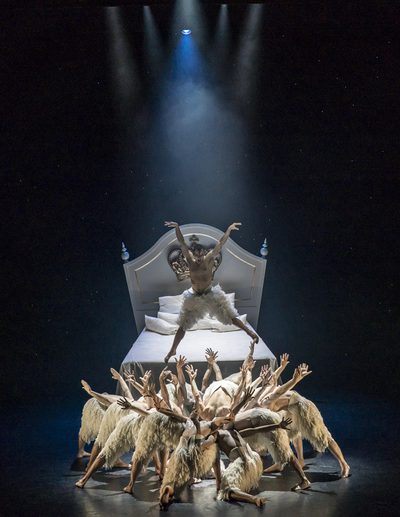
Over the years, we found ways of developing the bed – so the Swan coming out of the bed came later in the process. So, once we’d got the bed we found many, many things to do with it and that led us to design in a number of things, such as access through the bed, steps up to the bed, the way the bed would push, the way we could make it move; and of course, this has developed over the past 20 years too.
Collaboration
You have worked with Matthew for many years and have developed what Matthew describes as a ‘short-hand’ in the way you communicate your ideas to one another. Can you explain a little more about how a very successful and lengthy collaboration such as yours, evolves over time, and what you feel is the secret to a fruitful partnership between any designer and director?
There has to be an equality. With Matthew, what happens is, we just talk about the story – the story we’re trying to tell. And during those early meetings we throw ideas around until there is something that both of us can relate to and understand, admire, like and love. So, then we have something to go forward with.
Very often you don’t know whose idea, is whose idea, because it was a collaboration. It wasn’t one person telling the other person what they want. In Swan Lake the only thing that Matthew said he wanted to do, was for the Swans to be male and so everything came from that.
You’ve got to feel comfortable enough to be able to make suggestions that may be stupid, or laughable, and may be thrown out; because even if it is a terrible idea it may lead to something else. You’ve got to be able to have the freedom in those early meetings, to be able to offer things up to be thrown away and not feel as though you’ve done something wrong – it’s just a process.
The ‘short-hand’ comes in because Matthew and I are of a very similar age, of a very similar background, and like very much the same kind of things – we both like old films, we both like Hollywood – and whilst Matthew is much more knowledgeable about these things than I am, the ‘taste’ is there. So, we have a short-hand where we can say “like in Rebecca” or “like in AllAbout Eve” and we will both know what that means.
The way that Matthew works is quite specific, and I mean this as an enormous compliment. He’s not a ‘pure’ choreographer in the sense that he doesn’t come in with all the steps written down and tell everyone what ones to do. He makes people invent steps and then he will ’edit’ them. He really is a collaborator with a capital ‘C’.
What we end up with on stage is a sum of everybody’s creativity, with Matt as the arbiter. His enormous talent is to spot the good idea in the room – and he has a nose for it! And it may come from anybody – it may come from a dancer, it may come from a member of staff, it may come from me, it may come from Paule, it may come from anyone...but he has a great directorial instinct.
Ultimately it has to be filtered through one person in the end, because designing ‘by committee’ doesn’t work. And also, for example, costumes being designed by the people who are going to be wearing them can never work, because they can never divorce themselves from the character enough to know whether it works for the character, or not.
It’s always good to work with dancers, but not in the first stages of creating the characters, because they don’t have the overall view of the show at that stage and don’t know how they fit in relation to the other characters, and what the ‘pecking-order’ is of the other characters, for example. But, once I’ve got them in the room and I’m putting them into the costumes that I have designed for their character with them in mind, of course I’m having a dialogue with them about ‘can you cope with that skirt length?’, ‘do you think we should go a bit tighter on the sleeve?’etc.
Within the parameters of what we’re trying to achieve of course there is inclusion and there is ‘working together’, but it’s my job to remember what the other 30 people are wearing at the same time too; and so there might be a reason why you can’t have the colour you might like (because it has to work as an ensemble).
Swan Lake is a huge production and includes a cast of around 40 dancers. How many people work with you behind the scenes creating all the various set, prop and costume elements required for a show like this?
When I’m building the model, I work very closely with Colin Falconer, who has been my assistant for about 18/19 years. I describe and draw what I want he helps me make the model and with the drawings. The next person is the production manager, who is responsible for having it built - in this case Tom McEvilly.
I do the costume drawings myself, so the next person involved in that process is my costume supervisor, Diane Williams, and we are absolutely like best friends. I choose the fabrics we’re going to use, and we shop for them together and again, Diane and I have worked together for a very long time – 20-odd years.
Plus, I also work very closely with Paule Constable of course, the lighting designer.
When we show the model to the workshop we show it to the head of the workshop, and in-fact we worked with a couple of workshops this time around, but the main one was with Simon Kenny at Souvenir. Simon probably had 20 people working with him in the workshops. Rocket Scenery in Nottingham have also been making some of it too; and again, they’ll have perhaps 10-15 people in the workshop.
Lily Mollgard, the Prop Supervisor will have a team of 2-3 people in the theatre when we’re putting the show on. And there’s a particular painter, we go to called Julie Perren and she has a couple of people working for her, too.
When we’re in the theatre I’ve got Darren Ware working with me as the wig supervisor – I tell him what I want and he gets the wig made and fits them, and then I look at them and give him notes etc, plus there are 3 people in the wig department permanently maintaining the wigs every night. We also have a team of about 6 or 7 dressers, and on stage we’ve got a head fly man and 3 other men up in the flies as well (all operating the fly system to move the scenery). Plus 2 or 3 other crew.
So, we’ve got a massive machine behind us – it’s a huge organisation and a lot of these people have done this show for a very long time. Dylan Batdorff who moves the show every week whilst on tour has been working with the company for 18 or 19 years.
We are probably as big as we can be now, whilst still having a real sense of ‘family’ within the company. I think part of the success is the fact that we largely keep the same team of creatives and that means that they can develop their creativity over more than one project. You can challenge yourself every time, and also because we are part of a team of people that know one another and trust one another we can support one another to take risks.
For example, I couldn’t have gone into a company for the first time and given them the design for The Red Shoes set. It was a huge gauntlet that I threw down to the technical team, and had they not known and trusted me they would have just looked at me like I was mad because it was a huge and really complex bit of kit!
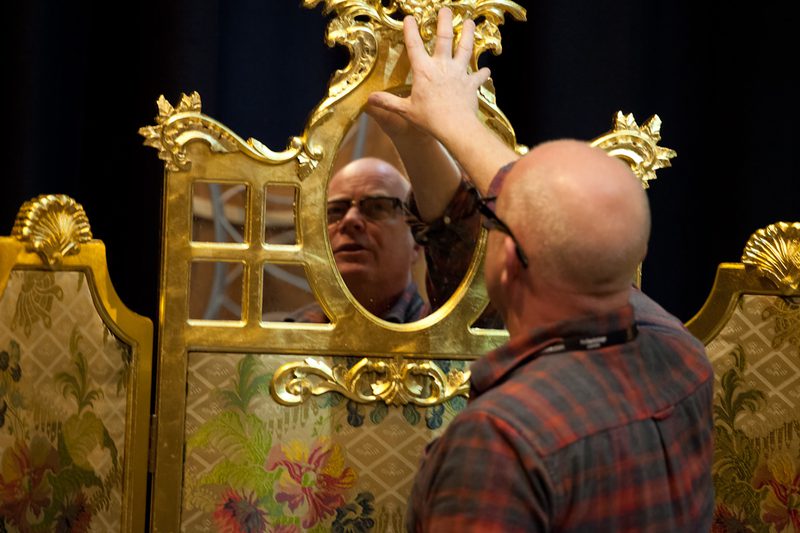
Career
In the lead-up to the premier people had begun to pick up on the fact that Matthew’s Swan Lake was going to be quite a big diversion from previous versions and the Swans being male was causing quite a controversy. Do you remember how you felt at that time and whether you were anxious about how it would be received?
There is always a nervousness about putting your work in front of a 1,000 people and you have no idea whether they are going to like it or dislike it. I remember on the very first opening night of Swan Lake (in 1995) at the old Sadler’s Wells, I was standing at the back and I saw Gillian Lynne there, and I knew that (with this show) I had done something that I’d hadn’t done before. And so, I had to make this pact with myself, that even if everybody hates it, I knew that I had I had made a ‘gear-change’ for me, because I’d not seen ‘me’ do ‘this’ on stage before.
Any show is nerve-wracking because you leave yourself open to criticism or misunderstanding, but I knew at the time that regardless of the way it would be received I had done something significant for me (in my career).
Go Back